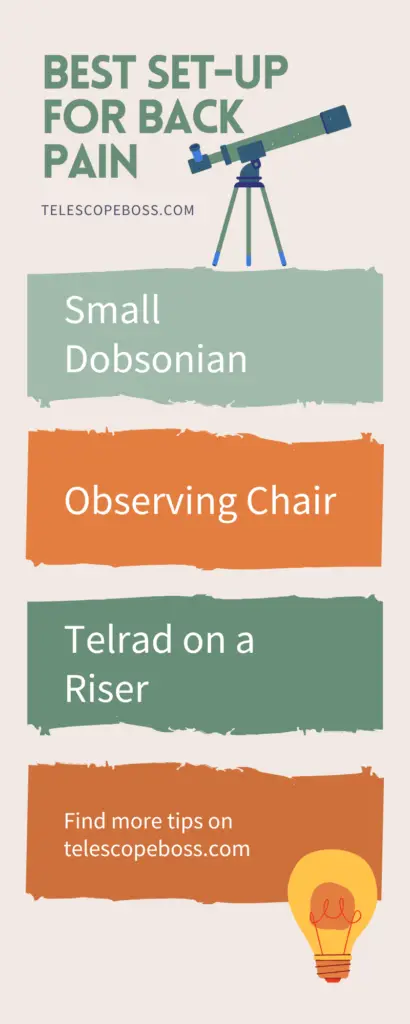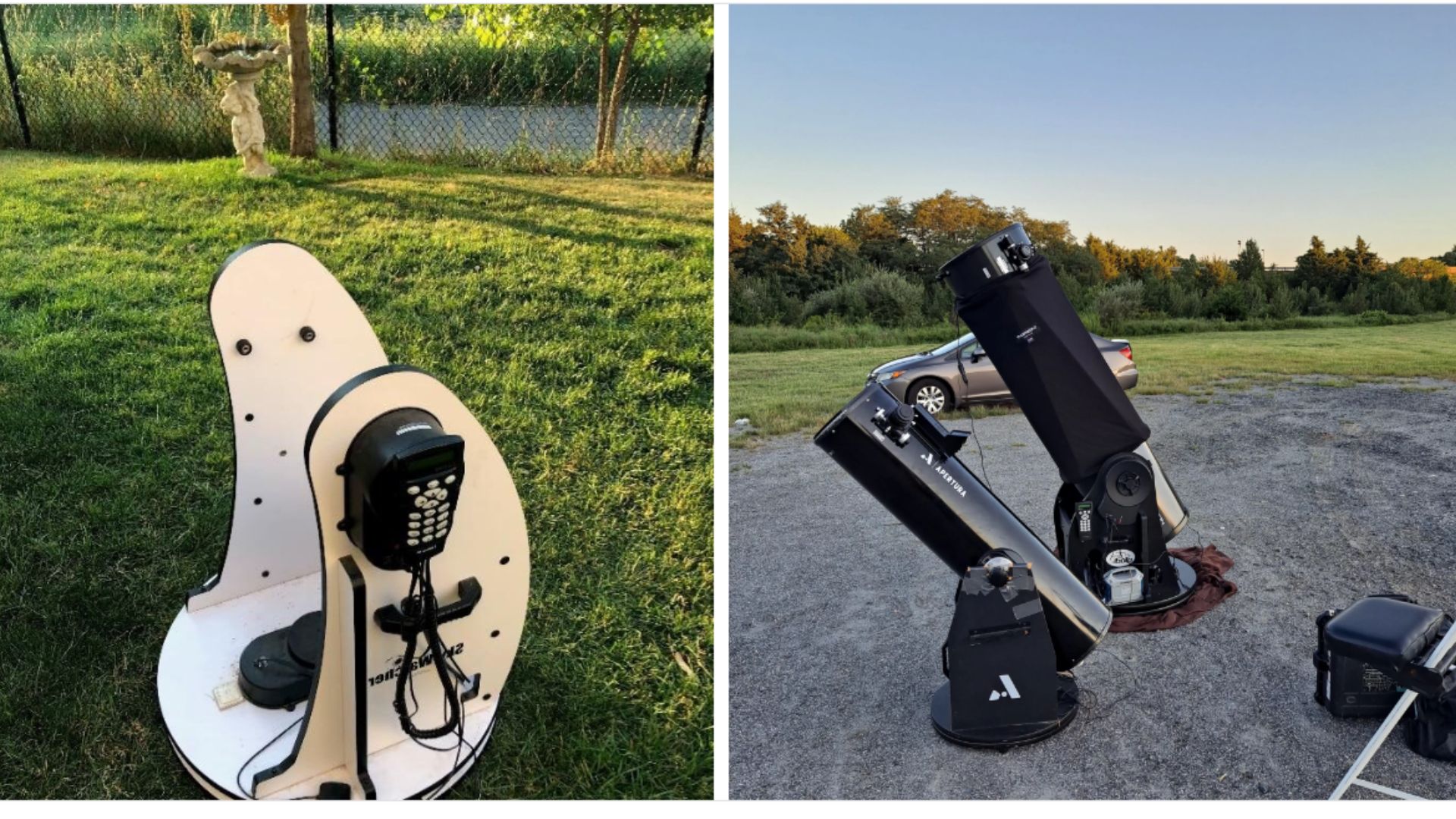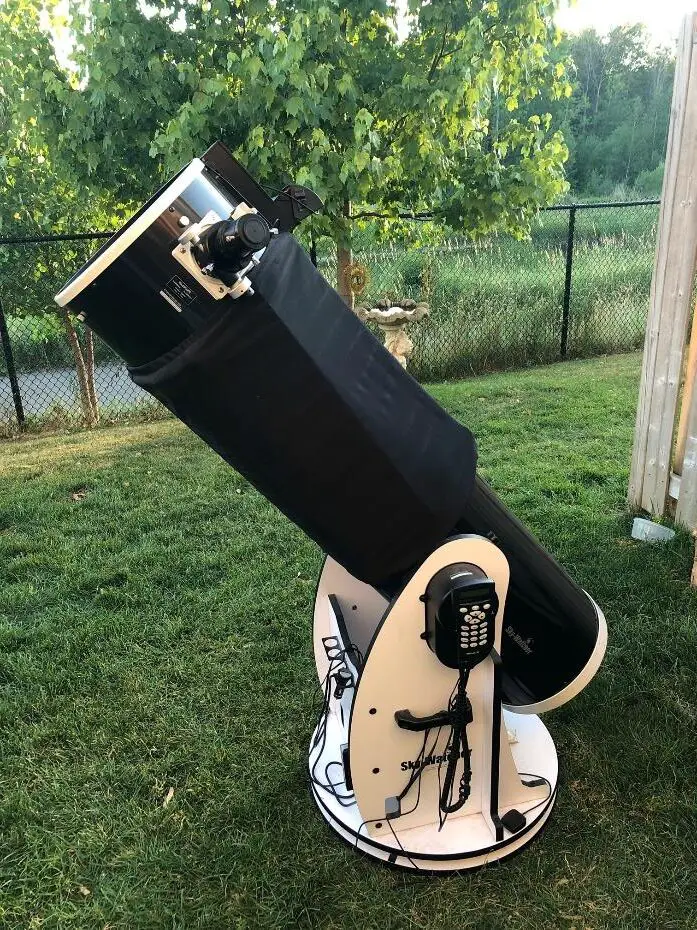I have had issues with chronic back pain since my early twenties! Using my telescope was tricky at first, but I have found a few things that have helped me observe pain free.
I have had two telescopes and I found that I am in very different positions when I use each one. I also travel very often with my telescope, so the weight of my scope was important.
This is what I have found to be important when observing with my back.
Sit Down In an Observing Chair
While it is possible to observe standing up when using most telescopes, sitting is more comfortable and will give you more time at the eyepiece.
While you may find that it is more comfortable to stand when you are observing initially, you will stay out longer and see more if you have a comfortable observing chair.
Some people use drum thrones, folding chairs, or kitchen stools, these are not as adjustable as a real observing chair. It may seem like an unnecessary purchase at first, but the difference in comfort is significant.
Get a Dobsonian
You may think that a smaller telescope on a tripod would be the most comfortable and adjustable telescope for someone with back pain, but I would recommend a small Dobsonian telescope. These scopes are just wonderful to use and the height of the eyepiece is very comfortable to use while seated.
I am a bit biased towards Dobsonian telescopes and I think everyone should start with a Dob. They are wonderful first telescopes and they will allow you to observe for years and years.
The larger aperture and lower price tag of these small Dobsonian telescopes is a telescope you will use frequently. They will give you spectacular views, are easy to move and comfortable to use.
Plan Ahead for Tear Down
When traveling with a telescope, consider the weight.
Tearing down my scope is hard on my back. This is the worst part for me, I have a very large heavy telescope, but I started with a 10” Dobsonian and that was very comfortable.
When you are looking for a telescope, consider the weight if you plan to travel to dark sites to observe. Although it is possible to observe living in the city, the views in a dark site are worth the trouble of traveling.
Know How Much A Dobsonian Telescope Weights
One popular brand of Dobsonian is the Apertura or GSO brand Manual Dobsonian Telescopes. They break down into two components, the Optical Tube and the Base.
Here are the weights of the popular smaller sizes. The number refers to the diameter of the optical tube, or the aperture of the telescope.
| Tube | Base | Total | |
| 6” Dobsonian | 19.84 lbs | 17.85 lbs | 37.69 lbs |
| 8” Dobsonian | 24.5 lbs | 27.7 lbs | 52.2 lbs |
| 10” Dobsonian | 34.8 lbs | 31.4 lbs | 66.2 lbs |
| 12” Dobsonian | 47.8 lbs | 38.3 lbs | 86.1 lbs |
You can see that the weights increase with size, choose the size that best suits your situation.
Larger aperture means more light gathering power, so you will be able to see more faint distant objects with a 12” over a 6”.
If you are planning to wheel it out of your garage, go big, if you plan to pack it in your car, choose one that fits! This post has some pictures of how I transport my large Dobsonian in my Honda Civic.
Telrad with a Riser
Back and neck pain may be a result of holding yourself in an awkward position to see something.
A Telrad is a finder that allows you to find objects more easily and quickly. Telrad’s are very useful and I recommend them to everyone, but for maximum comfort, put it on a riser.
A telrad riser is installed between the telrad and the optical tube and it puts the telrad in a more comfortable position in relation to the eyepiece.
From a seated position at the eyepiece you only need to raise your head to see directly through a telrad on a riser. When you start reading reviews of telrad risers you will see that many people find that it eliminates a bunch of pain from their observing sessions.
Change Targets
Even with a comfortable scope, observing chair and telrad riser you will find yourself in an awkward painful posture when trying to observe an object.
The position of the eyepiece when observing close to the horizon or close to the zenith may make it difficult to find a comfortable observing position.
Do not be discouraged, take an app like Sky Safari or Sky Map and scan the sky, find a new target to observe.
The sky will present itself differently in different seasons and you will get another chance to see the object.
Medication: Careful
I prefer not to take any pain medication before I go out to observe as it makes me sleepy and makes it hard for my eyes to focus well.
Follow any Doctor’s instructions about staying on a schedule with any prescribed medications, but discuss your new hobby and ask them if there is room to change your routine.
Anti-inflammatory supplements like Tumeric have been helpful for some people I know, but I have not taken it. Again, if you find observing too painful for your back, but your pain medication makes you sleepy, talk to your doctor to find a solution.
The Best Set-up For Someone With Back Pain
The most comfortable observing set up for someone with back pain would be a small Dobsonian telescope, an observing chair and a telrad on a riser.
A small Dobsonian, like an 8 or 10 inch Dobsonian gives a really comfortable height for observing.
The Telrad riser will put the telrad in a very comfortable position that will not require you to strain your neck into odd positions. Be sure to test out a few positions before permanently installing your telrad on a riser. I have an opinion on the best place to mount a Telrad, but it might not be the most comfortable for you.
Sitting is a much more comfortable position for me, although I do find myself standing much of the time with my new Orion XX16G, a very large Dobsonian. The smaller dob will put the eyepiece at a more comfortable position.






